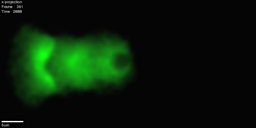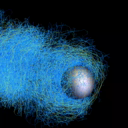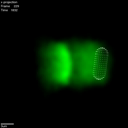CometWiki
|
This wiki describes the set up and usage of `comet', an actin-based bead motility simulator. IntroductionCell MovementCells in our body use actin to move. Unlike the actin-myosin interaction that produces muscle movement, this kind of movement is on a much smaller scale---the scale of individual cells---and allows, for example, neurons to migrate and wire up to the right part of the brain, and cells in our immune system to track down and engulf bacteria. To achieve this movement, cells lay down actin polymer networks that produce force. Bead MotilityOne popular way to study how our cells use actin networks to produce force and move is using a simplified system---actin-based bead motility---which recreates motility in vitro. To do this, we coat a bead with proteins that normally tell the cell to polymerize actin, then put the bead a solution similar to that inside of the cell, which causes an actin network to build around the bead. Surprisingly, even when the bead is spherically symmetric, rather than just building a symmetric shell that gets bigger and bigger, the bead moves off in 'comet tail' of actin. The Comet Bead-Motility SimulatorThis bead motility simulator (named 'Comet') helps us understand how this process works, by recreating the process in silico. It's a top-down model, based on idea that the large-scale elastic behavior of the network is the key to motility, rather than small-scale filament effects. Because it's able, by simulating the elastic behavior alone, not only to reproduce the experimental observations, but also to make new predictions that turn out to hold in the experimental system, it shows how the elastic behavior of the actin network works to produce motility. |
Essential InformationVideo TutorialsHow to run the comet program on OS X How to make 3D isosurfaces. How the program worksInstalling the program
Running the programThe program is called from the command line. The command line parameters tell the program what to do (calculate a new run, re-process existing data, interactive 3D view etc.). A |
Simulator OutputExample Results
Model RobustnessIn Vitro
In Depth InformationInner workings of the codeMaking Measurments |


